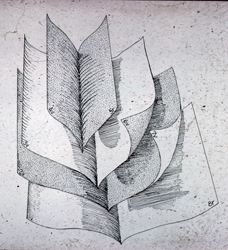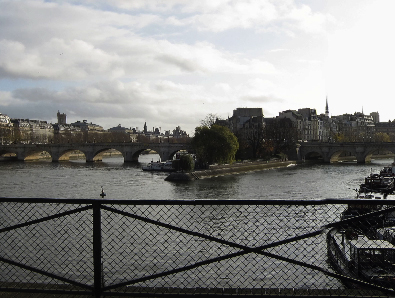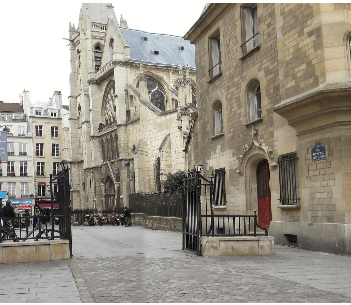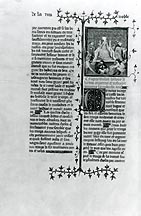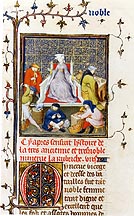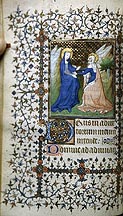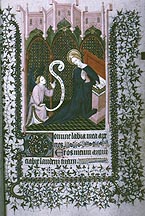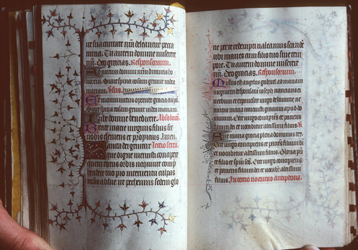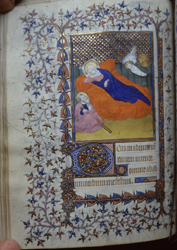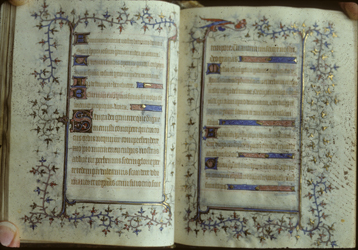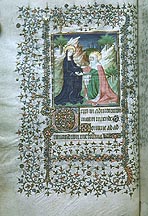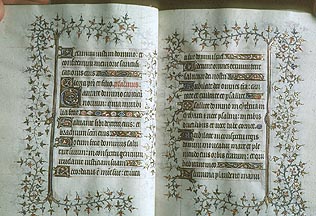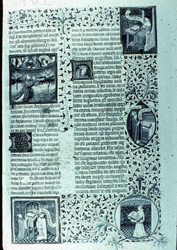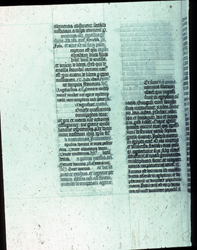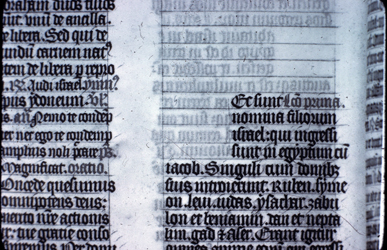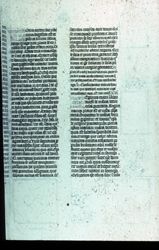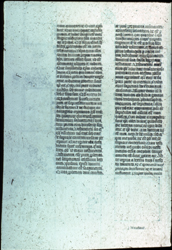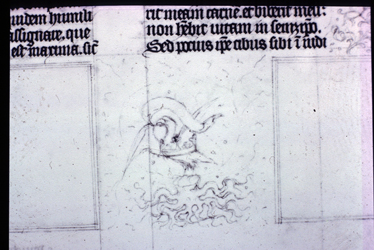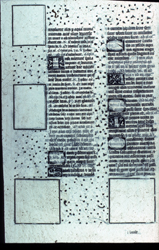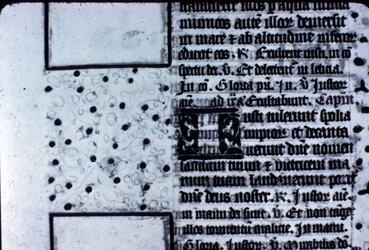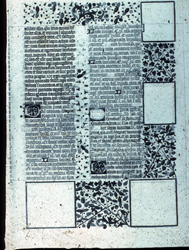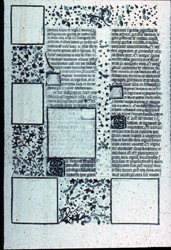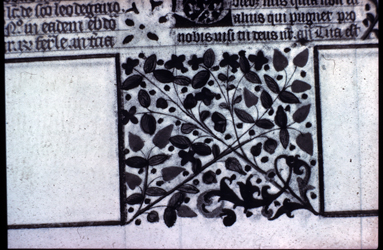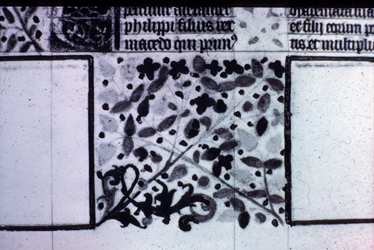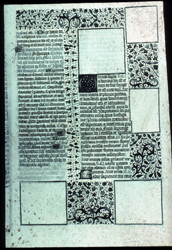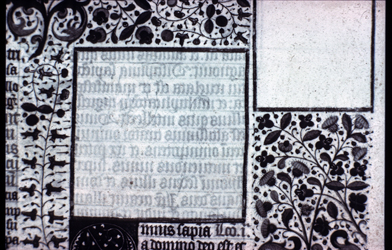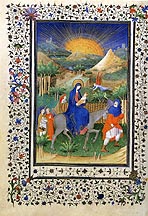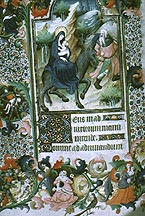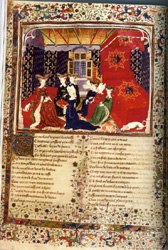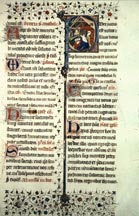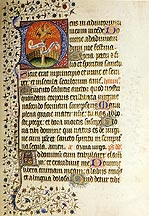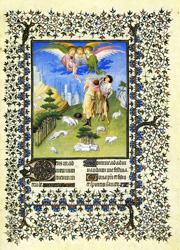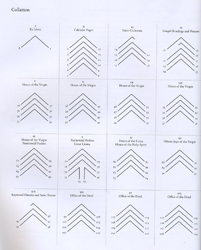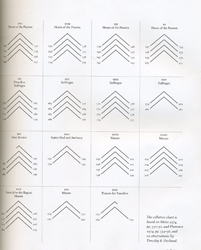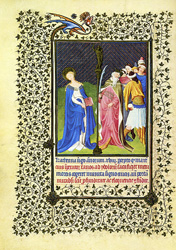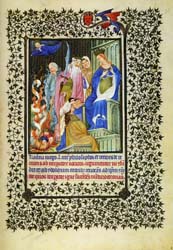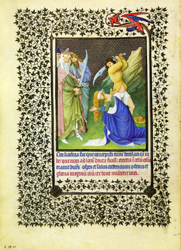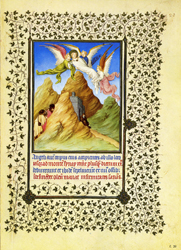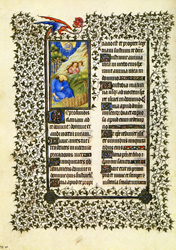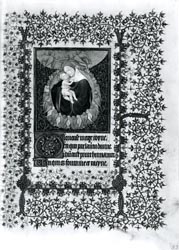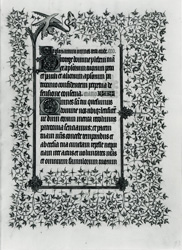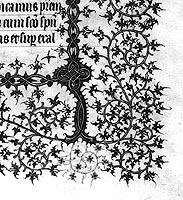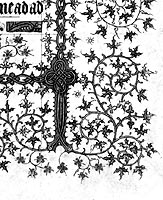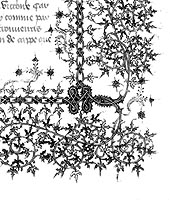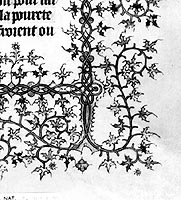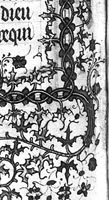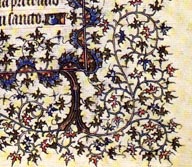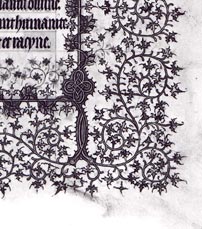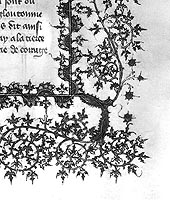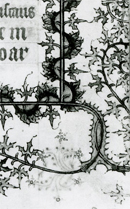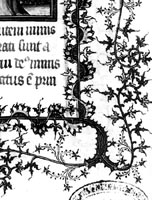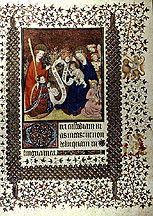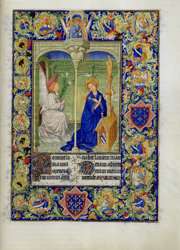Art Home | ARTH Courses | Marginal Matters | ARTH 214 Assignments | ARTH 294 Assignments
From Workshop to Chamber
Diagram of an 8 leaf gathering: Quaternion (8 folio or leaf gathering). A quaternion is composed of 4 bifolios. Conjugate folios form a bifolio at either end of a gathering or quire. So in the diagram above folios 1 and 8 which form a bifolio are conjugate folios. Codicology is a methodology developed by the Belgian art historian, L.M.J. Delaissé. Sometimes call the archaeology of the book, codicology attempts to examine the book as a totality. Most art historians previously had looked at miniatures without a serious examination of the context of the miniatures in a book as a whole. One can learn a lot about the making and history of a manuscript through examining all aspects of a manuscript.
|
|||||||
| October and June pages from the Trés riches heures. | |||||||
French Translation of Boccaccio's De Claris Mulieribus Paris, Bibliothèque nationale, fr. 12420, f. 13v: Minerva Miniature by the Coronation Master and decoration by the Cleres femmes B Decorator. |
|||||||
Paris, Bibliothèque nationale, fr. 159, f. 10v: Cain and Abel. Miniature by the Coronation Master and the decoration is by the Walters 231 Decorator. |
|||||||
Baltimore, Walters Art Museum. MS 209, f. 51v . Painted rinceaux with elaborate staff , gold ground foliate three line initial and penflourish 1-line initial and line ending. Decoration by Petrus Gilberti and the Sallust Decorator. |
|||||||
Baltimore, Walters Art Museum, MS 231, f. 17. Miniatures by the Luçon Master; Decoration by Walters 231 Decorator Painted rinceaux with elaborate staff , gold ground foliate three line initial and penflourish 1-line initial and line ending.
|
|||||||
Baltimore, Walters Art Museum, MS 232, f. 53v. Painted and penned rinceaux with elaborate staff. Gold ground foliate three-line initials and dentelle one-line initials and line endings. Decoration by the Walters 232 Decorator. |
|||||||
Baltimore, Walters Art Museum, MS 265, f. 56v. Painted rinceaux with elaborate staff. Gold ground three and one-line initials and line endings. Decoration by the Walters 265 Decorator. |
|||||||
Boucicaut Hours, Musée Jacquemart André. |
Oxford, Bodleian Library, Douce 144 Dated manuscripts: Note on f. 27: "anno Mo.CCCCo.VIIo. quo ceciderunt pontes Parisius." The bridges were swept away on January 30, 1408 (1407 old style). This indicates the note was written between the end of January and the end of March of 1408. |
||||||
Paris, Bibliothèque de l'Arsenal, MS 623: Missel de Saint-Magloire In August of 1412, the counsellor of the king and the master of the Chambre des comptes, Jean de la Croix and his wife Jeanne Coquatrix established a perpetual mass in the chapel of the Assumption and St. Eustache in the church of Saint-Magloire. This manuscript was given at this time. |
|||||||
Paris, Bibliothèque de l'Arsenal, MS 623: Missel de Saint-Magloire |
|||||||
New York, The Cloisters, The Belles Heures, f. 52: miniature by the Limbourg Brothers; secondary decoration is by the A Master of the Belles Heures. |
|||||||
New York, The Cloisters, The Belles Heures, f. 15v. Secondary decoration by the B Master of the Belles Heures. |
New York, The Cloisters, The Belles Heures, f. 16. Secondary Decoration by the A Master of the Belles Heures. |
||||||
New York, The Cloisters, The Belles Heures, f. 19v (conjugate folio to f. 16). Secondary decoration by the A Master of the Belles Heures. |
New York, The Cloisters, The Belles Heures, f. 20 (conjugate folio of f. 15). Secondary decoration by the B Master of the Belles Heures. |
||||||
New York, The Cloisters, The Belles Heures, f. 204. Secondary decoration by the A Master of the Belles Heures. |
New York, The Cloisters, The Belles Heures, f. 71v. Secondary decoration by the B Master of the Belles Heures. |
||||||
Paris, Bibliothèque nationale, Nouv. acq. lat. 3107 (the Saint Maur Hours) , f. 33. |
|||||||
|
|||||||
|
|||||||
London, British Library, Cotton Domitian AXVII (The Psalter of Henry VI), f. 74v-75. |
|||||||
| The following texts are from the accounts of Isabeau de Baviére, the wife of Charles VI and Queen of France. They were published by Vallet de Viriville, "La Bibliotheque d'Isabeau de Baviére, reine de France," Bulletin du bibliophile, 1858, pp. 663-87. | A lui [Robin de Fontainnes, enlumineur et escrivain], le vintiesme jour d'aoust ensuivant [1398], pour sa painne et salaire d'avoir enlumine pour la royne un petit livret, ou quel est contenue la Vie sainte Marguerite, et pluseurs versets de pluseurs saints, et y a trente vingnettes; chascun vingnete du pris de 12 d.p. valente 30 s.p., et un cent et demy de versets, 9 s.p.; pour tant, 39 s.p. To him, the 20th day of August following [1398], for his efforts and salary for having illuminated for the Queen a small book which contains the Life of St. Margaret, and severl verses of several saints, and there are 30 vingnettes; each vingnette at the price of 12 Parisian pence, equalling 30 Parisian sous, and 150 versets, 9 s.p.; pour tant, 39 s.p. |
||||||
A Pierre Le Portier, escripvain de lettre de fourme, demourant a Paris, pour sa painne et salaire d'avoir escript un petit livret, la ou est contenu la Vie saincte Marguerite, et trente suffrages de pluseurs sainz et avoir quis le parchemin; pout ce, le 20e jour du mois d'aoust, 32 s.p. To Pierre Le Portier, scribe of lettre de fourme, living in Paris, for his efforts and salary for having writtin a small book, which contains the Life of St, Margaret, and 30 suffrages of several saints and having acquired the parchment; for this, the 20th day of the month of August, 32 Parisian sous. [Probably the father (Jean I de la Fontaine) of Robin de Fontaines who decorated this manuscript had lived next door to Pierre's father, Jean de la Porte] |
A lui, le 20e jour de novembre en suivant, pour avoir escript de lettre de fourme en huit coyers de parchemin, en unes Heures de la royne, plusieurs oroisons, suffrages et besoingnes; pour chascun coyer 8 s.p., valent 64 s.p.; pour avoir nettoye, blanchy, corriegie, refourni, dore, relie et mis a point lesdites Heures, 54 s.p.; pour tout ce, 218 s.p. [sic, 118 s.p.] To him [Pierre Le Portier], on the 20th day of November, for having written in lettre de fourme in 8 quires for parchment, in an Hours of the queen, several prayers, suffrages and request; for each quire 8 Parisian sous, equalling 64 Parisian sous; for having cleaned, whitened, corrected, refournished, gilded, bound the said Hours, 54 Parisian sous; for all this, 218 Parisian sous [actually it was probably 118 s.p.] |
||||||
A Jehan de Jouy, le 24e jour du mois de juing ensuivant [1399] pour avoir fait par ordonnance de la royne, en ces vieilles Heures, deux histoires, de blanc et de noir, de la Croix et du Saint-Esprit; au pris de 8 s.p.; pour avoir fait en unes neuves pour ladite dame vingt histoires en fines couleurs au pris de 8 s.p. chacune histoire, 8 l.p. To Jehan de Jouy, the 24th day of the month of Junr following, for having made by the command of the queen, in her old Hours, 2 histoire in white and black, of the Cross and the Holy Spirit; at the price of 8 Parisian sous; for having made in a new [hours] for the said lady 20 histoires in fine colors at the price of 8 Parisian sous for each histoire, 8 Parisian pounds, |
The accounts of Charles V have the following 1378 entry for Jean Bondol: "Johannes Bandol, pictor regis, ad vadia [ed. valia] de 200 l. p. per annum, tali conditione, quod tenebitur servire in omnibus operagiis precipiet fieri, tam pro se quam pro famulo suo." "To Jean Bondol, painter of the king, wages of 200 l.p. per annum, with this condition: that he is to perform whatever works the king orders to be done, whether for the king or for members of his court [famulo suo]."
|
||||||
| A document of 1368 records the presentation by Charles V of a stone house to Jean Bondol who is identified as "valet de chambre." | |||||||
Documents pertaining to Jacques de Besancon: Note in Paris, Bibl. Mazarine, ms. 461: L'mil IIIIc IIIIxx cinq [1485] fut fait ce livre, en l'onneur de dieu et de la glorieuse Vierge Marie et de Monseigeur Saint-Jehan l'Euvangeliste, par Jacques de Besancon enlumineur, lui estant bastonier de la confrarie monseigneur Saint Jehan, fondee en l'Eglise Saint Andry des Arts a Paris, pour servir a ladicte confrarie. Et prye aux freres et suers qu'ils pryent Dieu et Monseigneur Saint Jehan l'Euvangeliste pour lui, et qui plaise au benoit accepterile petit don. This book was made in 1485, in honbor of God and the glorious Virgin Mary at of My Lord St. John the Evangelist, by Jacques de Besancon the illuminator, who was the staff bearer for the confraternity of My Lord St. John, fonded in the Church of St. Andrew of the Arts in Paris, for the use of the said confraternity. And Pray to the brothers and sisters that they pray to God and My Lord S. John the Evangelist for him, and please accept this small gift. |
Archives of the Hospital of Saint Jacques aux Pelerins has the following entry dated 1485: Jacques de Besancon undertook by agreement: "de enluminer le greel nouveau fait et avoir pour les grans lettres qui aront baston, c'est a savoir la premiere a baton au long de la page hault et bas les autres au long de la page, XI s.- pour tourner et florir les grans lettres qui seront d'azur et de vermilhon, XI s, pour cent- et pour IIIIc de petites lettres fleuries, XI s.. Et a receu XVII cayers le XXIIe juing mil CCCC IIIIxx et cinq. to illuminate the newly made gradual, and he should have for the large letters which have staffs, knowing that the first has a staff along the length of the page top and bottom, the others along the length of the page, 11 sous -- to shape and flourish the large letters which will be azure and vermilion, 11 sous for each hundred -- and for 400 small flourished letters, 11 sous. And he received 17 gatherings on 22 June, 1485. |
||||||
|
|||||||
Oxford, Bodleian Library, Douce 144, folio 28. A note on folio 27, apparently written by the scribe, states : "factum et completum est anno M'. CCCC'. VII' quo ceciderunt pontes par." That the bridges of Paris were swept away by floods a t the end of January, 1408, indicates a date for this note between then and the end of March of 1408. |
|||||||
The following three miniatures are frontispieces in different manuscripts for the same text. Fortunately we have the written instructions composed by Jean Lebègue, a court official. Compare these instructions to these illustrations: Paris, Bibliothèque nationale, Lat. 9684: Sallust, Catilina, about 1404. Copy made under the supervision of Jean Lebègue for the sons Louis d'Orléans |
Paris, Bibliothèque nationale, Lat. 5762: Sallust, The Conspiracy of Catiline and the Jugurthine War, 1404-1405. Copy made for Jean Lebègue. The Jugurthine Wars (fols. 37-108) were added to the manuscript in the 1430s (Hedeman, 2006, p. 179). Lat. 5762 has been considered a twin of Lat. 9684. This is supported that the same decorator was responsible for the decoration of the frontispieces of both manuscripts. Hedeman notes that the same scribe and decorator are responsible for the original portions of both manuscripts. |
||||||
Jean Lebègue, a court official, translator, and author, wrote a extensive set of instructions for how to illustrate texts of Catalina and Jugurtha of Sallust. What follows is a translation of the instructions for the frontispiece: Make a man with a long forked beard who is wearing a white cap like those that used to be worn. And he will be seated on a chair which is well built and in front of him will be a small table on which he will seem to be writing and (there will be) everything needed by a writer when he is in his chair in order to write. And the foresaid writer will be dressed in a vermilion coat, or of another color, with a lower collar and open in the front so that his armor can be seen above and below, and he will also have leg armor and golden spurs. And outside the edifice with his chair, will be his squire, mounted on a gray horse in a gilded harness, holding in his left hand a lance with a pennant and in his other hand his master's horse in a gilded harness; one will see only the front half of this horse because the other half will be hidden by the foresaid chair, signifying that the foresaid man who is writing will have left knighthood for study and, as said, the foresaid squire will be in a beautiful plain which will have grass and trees of various types and in addition there will be a background in the miniature, high-up, pleasingly made. |
|||||||
